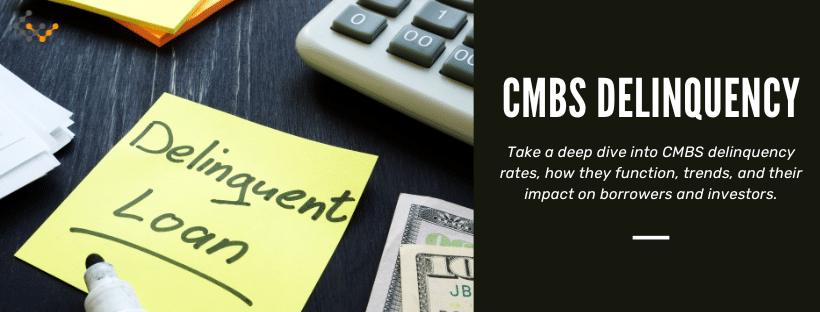A Guide to CMBS Delinquency Rates

The commercial mortgage backed securities (CMBS) rate has been fluctuating in recent years, and sometimes has spiked as the commercial real estate landscape adjusts to new work habits. Because CMBS are borrowed by real estate investors and purchased by securities investors, delinquency rates can affect both parties. Here’s a guide to CMBS delinquency.
Understanding Delinquency Rates
At its core, a delinquency rate quantifies the proportion of loans that are overdue or in default. Borrowers become delinquent on loan when they fail to meet scheduled payment deadlines. Past-due time frames of 30, 60 and 90 days are commonly used in commercial real estate (and for other loans).
The delinquency rate of commercial mortgage backed securities can impact real estate investors even if they personally aren’t behind on any loans. The loans have far-reaching impacts, and lenders consider market-wide delinquency rates when assessing requirements and rates.
Answer a few questions and get custom mortgage quotes. We'll match you with offers from our network of 650+ lenders.
How Does CMBS Delinquency Work?
CMBS are financial securities underpinned by a collection of commercial mortgages. The properties tied to these mortgages can range from office buildings and shopping malls to hotels — which includes a few notable parts of commercial real estate that have been struggling in some areas.
The process of delinquency with a CMBS on any property type works much like any other real estate loan delinquency. Real estate investors don’t make payments. The lender tries to collect payment. If payment isn’t made in a timely fashion, foreclosure ensues.
Where CMBS delinquencies differ from other real estate loan delinquencies is in who’s impacted by the failed payment. Not only are lenders impacted, but the investors who hold CMBS securities are affected. When payment failure leads to foreclosure, investors may not recoup the loan’s full value if a property only sells for less.
CMBS real estate loans are packaged together to spread this risk out over many loans. When delinquency and default rates rise across the board, however, investors holding CMBS securities can still sustain losses.
What is the Delinquency Rate on CMBS?
In simple terms, the CMBS delinquency rate is a measure of the total balance of CMBS that is overdue.
To compute the delinquency rate on CMBS, divide the entire delinquent loan balance by the overall outstanding CMBS balance. The delinquency rate formula is as follows:
Delinquency Rate = Delinquent Balance / Total Outstanding Balance x 100%
Trends in CMBS Delinquency Rates
CMBS delinquency rates, over time, have not been static. Often, they are swayed by larger economic forces:
- Boom Cycles: Economic booms usually see commercial properties flourish, which naturally leads to dips in CMBS delinquency rates.
- Recessions: The opposite holds during economic downturns. As businesses face hardships and rental yields fall, there is a consequent surge in CMBS delinquencies.
Delinquency rates have historically been roughly 5% or below, but they hit a high of 13.9% during the 2008 financial crisis. More recently, the rate was 3.04% in December 2022, and is forecasted to reach a possible 4.5% by the end of 2023.
Office and industrial property CMBS loans spiked during the pandemic, as offices went to remote work and industrial facilities struggled with supply chain issues. Both delinquency rates declined toward the end of the pandemic, however, and have since stabilized.
Across all property types, delinquency rates have been fairly steady since at least December 2021. They peaked at 4.98% during the pandemic, which was far below that of the Great Recession. This could be due to stimulus, the fact that underlying issues weren’t system financial problems and other reasons.
The recent shifts upward represent the first real trending increase in delinquency rates since the pandemic, but even an increase to 4.5% is still substantially below the pandemic spike.
Recognizing and understanding these trends is invaluable. They not only offer a historical context but also enable stakeholders to forecast potential market shifts, allowing for proactive planning and decision-making.
Impact of CMBS Delinquency Rates
CMBS delinquency rates directly impact both borrowers and investors, although in different ways.
Impact to Borrowers
When CMBS delinquency rates rise, the repercussions for potential borrowers can be far-reaching:
- Stricter Lending Standards: With a more considerable amount of delinquencies, lenders naturally become more risk-averse, leading them to tighten their underwriting standards. This makes it difficult for new borrowers to access loans.
- Elevated Interest Rates: To balance out the perceived increase in risk, lenders may hike interest rates, making loans pricier for borrowers.
- Refinancing Hurdles: For those borrowers looking to refinance, a higher delinquency environment can pose significant challenges. Lenders, sensing increased risks, might become more hesitant or demand stricter terms.
Impact to Investors
For those with investments in CMBS, heightened delinquency rates can bring about several challenges:
- Interrupted Cash Flow: Delinquent loans translate to disrupted cash flows from interest payments. This disruption can, in turn, diminish the overall returns or yield of the CMBS.
- Potential Losses: If properties underpinning the CMBS move into foreclosure and subsequently are sold at a loss, investors face the risk of not recuperating their entire principal amount.
- Market Perception: A surge in delinquency rates can color market perceptions negatively. This perception can reduce demand for CMBS, potentially driving down prices in the secondary market.
Wrapping Things Up
Commercial mortgage-backed securities are a common method of investing for both real estate investors and securities investors. The first uses these loans to leverage property purchases, and the latter uses them to hopefully get returns on the interest owed. Both parties should understand CMBS loans — and specifically the impacts of CMBS delinquency rates — well.

